AMD Zen 3 Ryzen Deep Dive Review: 5950X, 5900X, 5800X and 5600X Tested
by Dr. Ian Cutress on November 5, 2020 9:01 AM ESTCPU Tests: Simulation
Simulation and Science have a lot of overlap in the benchmarking world, however for this distinction we’re separating into two segments mostly based on the utility of the resulting data. The benchmarks that fall under Science have a distinct use for the data they output – in our Simulation section, these act more like synthetics but at some level are still trying to simulate a given environment.
DigiCortex v1.35: link
DigiCortex is a pet project for the visualization of neuron and synapse activity in the brain. The software comes with a variety of benchmark modes, and we take the small benchmark which runs a 32k neuron/1.8B synapse simulation, similar to a small slug.
The results on the output are given as a fraction of whether the system can simulate in real-time, so anything above a value of one is suitable for real-time work. The benchmark offers a 'no firing synapse' mode, which in essence detects DRAM and bus speed, however we take the firing mode which adds CPU work with every firing.
The software originally shipped with a benchmark that recorded the first few cycles and output a result. So while fast multi-threaded processors this made the benchmark last less than a few seconds, slow dual-core processors could be running for almost an hour. There is also the issue of DigiCortex starting with a base neuron/synapse map in ‘off mode’, giving a high result in the first few cycles as none of the nodes are currently active. We found that the performance settles down into a steady state after a while (when the model is actively in use), so we asked the author to allow for a ‘warm-up’ phase and for the benchmark to be the average over a second sample time.
For our test, we give the benchmark 20000 cycles to warm up and then take the data over the next 10000 cycles seconds for the test – on a modern processor this takes 30 seconds and 150 seconds respectively. This is then repeated a minimum of 10 times, with the first three results rejected. Results are shown as a multiple of real-time calculation.
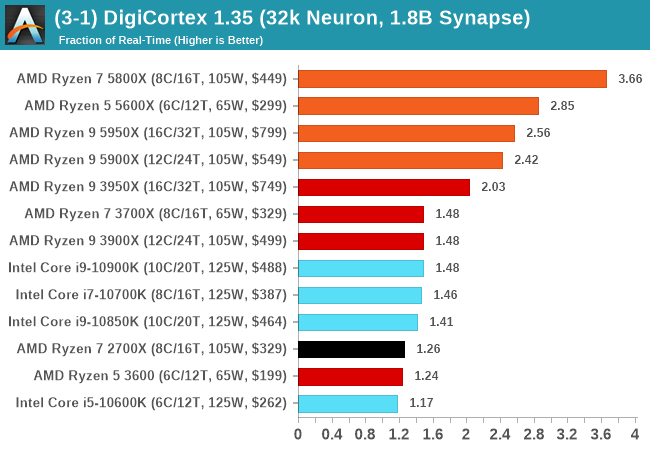
Dwarf Fortress 0.44.12: Link
Another long standing request for our benchmark suite has been Dwarf Fortress, a popular management/roguelike indie video game, first launched in 2006 and still being regularly updated today, aiming for a Steam launch sometime in the future.
Emulating the ASCII interfaces of old, this title is a rather complex beast, which can generate environments subject to millennia of rule, famous faces, peasants, and key historical figures and events. The further you get into the game, depending on the size of the world, the slower it becomes as it has to simulate more famous people, more world events, and the natural way that humanoid creatures take over an environment. Like some kind of virus.
For our test we’re using DFMark. DFMark is a benchmark built by vorsgren on the Bay12Forums that gives two different modes built on DFHack: world generation and embark. These tests can be configured, but range anywhere from 3 minutes to several hours. After analyzing the test, we ended up going for three different world generation sizes:
- Small, a 65x65 world with 250 years, 10 civilizations and 4 megabeasts
- Medium, a 127x127 world with 550 years, 10 civilizations and 4 megabeasts
- Large, a 257x257 world with 550 years, 40 civilizations and 10 megabeasts
DFMark outputs the time to run any given test, so this is what we use for the output. We loop the small test for as many times possible in 10 minutes, the medium test for as many times in 30 minutes, and the large test for as many times in an hour.
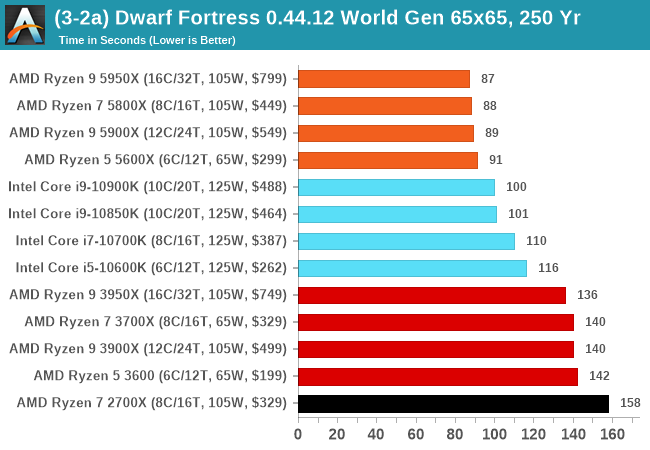
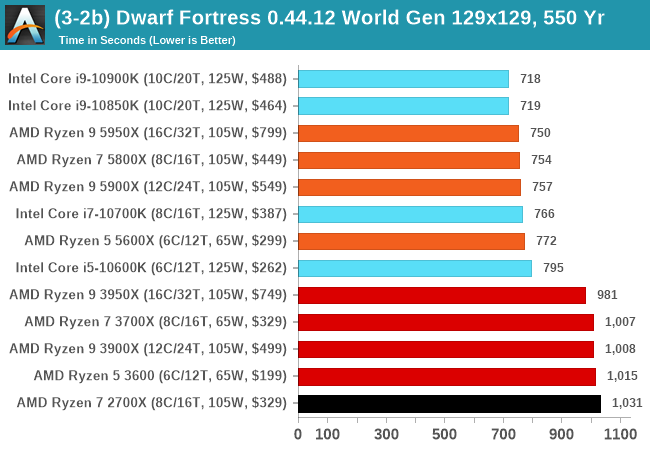
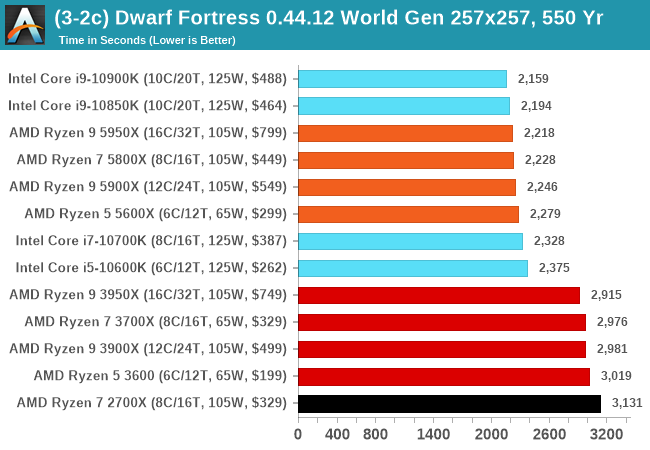
Dolphin v5.0 Emulation: Link
Many emulators are often bound by single thread CPU performance, and general reports tended to suggest that Haswell provided a significant boost to emulator performance. This benchmark runs a Wii program that ray traces a complex 3D scene inside the Dolphin Wii emulator. Performance on this benchmark is a good proxy of the speed of Dolphin CPU emulation, which is an intensive single core task using most aspects of a CPU. Results are given in seconds, where the Wii itself scores 1051 seconds.
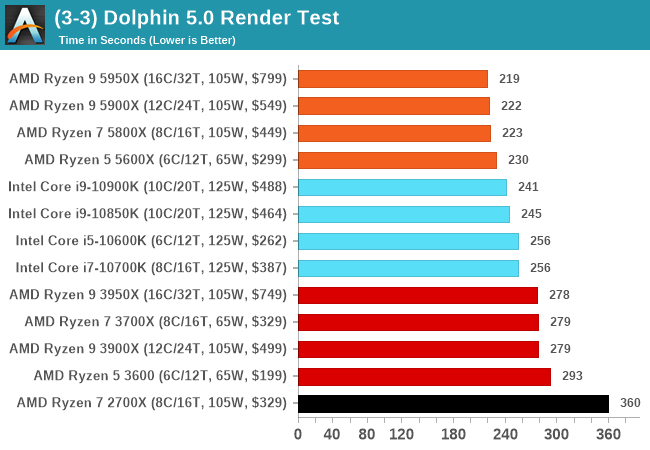












339 Comments
View All Comments
San Pedro - Thursday, November 5, 2020 - link
Looking at 1440p min and 1080p max gaming settings, I'm thinking that for 1440p max gaming, my 2700x is still able to hang in there, even if I were to get a top end graphics card.mrvco - Thursday, November 5, 2020 - link
Depends upon the game and what else you may doing while games (e.g. streaming, transcoding your pr0nstash, etc.), but yes, GPU performance is going to be far more important than CPU at 1440P. Hence the low resolution benchmarks in CPU reviews and higher resolution benchmarks in GPU reviews.defaultluser - Thursday, November 5, 2020 - link
Looks like an excellent upgrade over Zeb 2 - just a bit confusing because you added the 5900X and 5950x to Bench, but you haven't added the 6 coer 8 core Zen 3.Want to do a complete comparison of my 4790k before I jump onboard (but don't want more than a 5800X) :D
anactoraaron - Thursday, November 5, 2020 - link
Did I read that right about the memory used is ddr4 3200 but you are running it at 2133?? Because 'home users' won't change the bios to enable xmp? Did I read this wrong? I simply cannot comprehend that an enthusiast site like this would even consider taking this stance, it's as if you seem to not understand who actually reads these deep dive articles.I removed AT from my favorites bar about a month ago, when rtx 3000 was absent and new articles seemingly were just sponsored links or 'hey this thing is on sale' type of content. I was surprised to see this deep dive article and was wondering if I made a poor choice removing AT from my sources of tech content. But it appears you no longer recognize who your faithful old readers are anymore...
So home users will read the deep dive content and understand the core improvements and latency tradeoffs, but can't flick a box in the bios to enable xmp?
This reeks of intel fuckery (to keep them artificially relevant in gaming), as it is widely known that ryzen thrives - especially in gaming - using faster ram. And to do that in the desktop space this requires xmp. But hey, don't let me stop you from being the only site to run at jedec. Just know you aren't helping yourselves retain viewership/readers. I'm out, AT. Good luck in the future and Godspeed.
Icehawk - Thursday, November 5, 2020 - link
They repeat this mantra of "no one uses XMP" which I think is patently crazy - it is a one button change and folks who actually care about granular performance of a CPU will use it. At the very least it would be nice to see a selection of benchmarks showing scaling, if any.Spunjji - Sunday, November 8, 2020 - link
Not really how they ever justified it but go off I guessjust4U - Thursday, November 5, 2020 - link
They gave the Ryzen 5000 series a gold award.. I'd say that alone shows what they think of it..Ryan Smith - Thursday, November 5, 2020 - link
"Did I read that right about the memory used is ddr4 3200 but you are running it at 2133"No. To clarify, we run at the highest JEDEC-rated speed the chip supports. In the case of the Ryzen 5000 series, that's DDR4-3200.
Spunjji - Sunday, November 8, 2020 - link
For everyone's sake, please read the article before posting an ill-informed rantTristanSDX - Thursday, November 5, 2020 - link
Witout doubts Zen 3 is superior, but most IPC comes from large L3 cache. Also bit dissapointment, that then can not reach faster clocks for third trial, with Zen2 and Zen2 refresh (XT) before. And these prices, pretty sad.